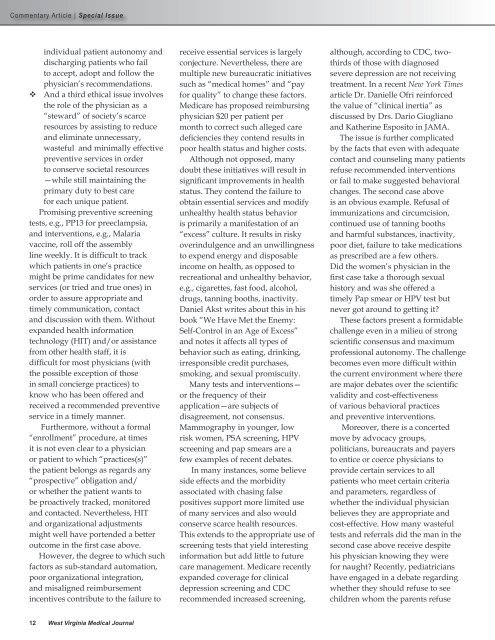Special CME Issue - West Virginia State Medical Association
Special CME Issue - West Virginia State Medical Association
Special CME Issue - West Virginia State Medical Association
You also want an ePaper? Increase the reach of your titles
YUMPU automatically turns print PDFs into web optimized ePapers that Google loves.
Commentary Article | <strong>Special</strong> <strong>Issue</strong><br />
individual patient autonomy and<br />
discharging patients who fail<br />
to accept, adopt and follow the<br />
physician’s recommendations.<br />
And a third ethical issue involves<br />
the role of the physician as a<br />
“steward” of society’s scarce<br />
resources by assisting to reduce<br />
and eliminate unnecessary,<br />
wasteful and minimally effective<br />
preventive services in order<br />
to conserve societal resources<br />
—while still maintaining the<br />
primary duty to best care<br />
for each unique patient.<br />
Promising preventive screening<br />
tests, e.g., PP13 for preeclampsia,<br />
and interventions, e.g., Malaria<br />
vaccine, roll off the assembly<br />
line weekly. It is difficult to track<br />
which patients in one’s practice<br />
might be prime candidates for new<br />
services (or tried and true ones) in<br />
order to assure appropriate and<br />
timely communication, contact<br />
and discussion with them. Without<br />
expanded health information<br />
technology (HIT) and/or assistance<br />
from other health staff, it is<br />
difficult for most physicians (with<br />
the possible exception of those<br />
in small concierge practices) to<br />
know who has been offered and<br />
received a recommended preventive<br />
service in a timely manner.<br />
Furthermore, without a formal<br />
“enrollment” procedure, at times<br />
it is not even clear to a physician<br />
or patient to which “practices(s)”<br />
the patient belongs as regards any<br />
“prospective” obligation and/<br />
or whether the patient wants to<br />
be proactively tracked, monitored<br />
and contacted. Nevertheless, HIT<br />
and organizational adjustments<br />
might well have portended a better<br />
outcome in the first case above.<br />
However, the degree to which such<br />
factors as sub-standard automation,<br />
poor organizational integration,<br />
and misaligned reimbursement<br />
incentives contribute to the failure to<br />
receive essential services is largely<br />
conjecture. Nevertheless, there are<br />
multiple new bureaucratic initiatives<br />
such as “medical homes” and “pay<br />
for quality” to change these factors.<br />
Medicare has proposed reimbursing<br />
physician $20 per patient per<br />
month to correct such alleged care<br />
deficiencies they contend results in<br />
poor health status and higher costs.<br />
Although not opposed, many<br />
doubt these initiatives will result in<br />
significant improvements in health<br />
status. They contend the failure to<br />
obtain essential services and modify<br />
unhealthy health status behavior<br />
is primarily a manifestation of an<br />
“excess” culture. It results in risky<br />
overindulgence and an unwillingness<br />
to expend energy and disposable<br />
income on health, as opposed to<br />
recreational and unhealthy behavior,<br />
e.g., cigarettes, fast food, alcohol,<br />
drugs, tanning booths, inactivity.<br />
Daniel Akst writes about this in his<br />
book “We Have Met the Enemy:<br />
Self-Control in an Age of Excess”<br />
and notes it affects all types of<br />
behavior such as eating, drinking,<br />
irresponsible credit purchases,<br />
smoking, and sexual promiscuity.<br />
Many tests and interventions—<br />
or the frequency of their<br />
application—are subjects of<br />
disagreement, not consensus.<br />
Mammography in younger, low<br />
risk women, PSA screening, HPV<br />
screening and pap smears are a<br />
few examples of recent debates.<br />
In many instances, some believe<br />
side effects and the morbidity<br />
associated with chasing false<br />
positives support more limited use<br />
of many services and also would<br />
conserve scarce health resources.<br />
This extends to the appropriate use of<br />
screening tests that yield interesting<br />
information but add little to future<br />
care management. Medicare recently<br />
expanded coverage for clinical<br />
depression screening and CDC<br />
recommended increased screening,<br />
although, according to CDC, twothirds<br />
of those with diagnosed<br />
severe depression are not receiving<br />
treatment. In a recent New York Times<br />
article Dr. Danielle Ofri reinforced<br />
the value of “clinical inertia” as<br />
discussed by Drs. Dario Giugliano<br />
and Katherine Esposito in JAMA.<br />
The issue is further complicated<br />
by the facts that even with adequate<br />
contact and counseling many patients<br />
refuse recommended interventions<br />
or fail to make suggested behavioral<br />
changes. The second case above<br />
is an obvious example. Refusal of<br />
immunizations and circumcision,<br />
continued use of tanning booths<br />
and harmful substances, inactivity,<br />
poor diet, failure to take medications<br />
as prescribed are a few others.<br />
Did the women’s physician in the<br />
first case take a thorough sexual<br />
history and was she offered a<br />
timely Pap smear or HPV test but<br />
never got around to getting it?<br />
These factors present a formidable<br />
challenge even in a milieu of strong<br />
scientific consensus and maximum<br />
professional autonomy. The challenge<br />
becomes even more difficult within<br />
the current environment where there<br />
are major debates over the scientific<br />
validity and cost-effectiveness<br />
of various behavioral practices<br />
and preventive interventions.<br />
Moreover, there is a concerted<br />
move by advocacy groups,<br />
politicians, bureaucrats and payers<br />
to entice or coerce physicians to<br />
provide certain services to all<br />
patients who meet certain criteria<br />
and parameters, regardless of<br />
whether the individual physician<br />
believes they are appropriate and<br />
cost-effective. How many wasteful<br />
tests and referrals did the man in the<br />
second case above receive despite<br />
his physician knowing they were<br />
for naught? Recently, pediatricians<br />
have engaged in a debate regarding<br />
whether they should refuse to see<br />
children whom the parents refuse<br />
12 <strong>West</strong> <strong>Virginia</strong> <strong>Medical</strong> Journal















